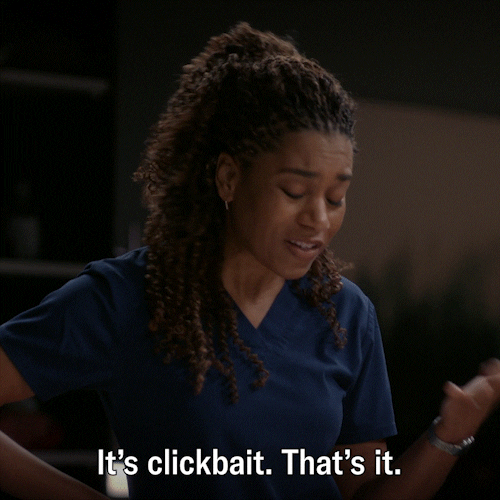Zoey Bahena • October 9, 2025
A Look at Rage-Baiting in Digital Marketing
- PR ON THE GO Expert Panel

Author: Zoey Bahena
Zoey is currently a student majoring in Communication at the University of California, Santa Barbara. Her passion in advertising and music has allowed her to explore the different ways that public relations shapes viewer engagement. She is always looking for new ways to connect with others and keep up with current trends.
“Rage-baiting” is a term often used to describe how content creators or media companies intentionally publish a controversial or even inaccurate take on certain situations. The purpose of this is to make the audience frustrated, which then brings in more viewer engagement. Although the media will reach more people, this specific approach can affect the brand’s image and even attract negative feedback. This strategy has become more normalized, especially on social media, where brands purposely voice the minority opinion in order to go viral.
I asked our PR & growth experts: Is “rage-baiting” on social media platforms a smart tactic to use in order to attract more viewers/audience?
Here are the experts' insights.
- Opt for authenticity over everything else
- Focus on thought-provoking content
- Try curiosity-driven provocation
- Rage-baiting drives reactions, not relationships.
- Rage-baiting kills conversion rates
- You give up integrity for impressions
- It brings an audience that is looking for conflict
- A loss of trust cannot be reversed
- It poisons long-term brand equity
- Integrity is compounding
- Outrage is selling loyalty for noise

Opt for authenticity over everything else
Emily Reynolds-Bergh, Owner at R Public Relations
"Rage baiting is not a wise tactic to employ unless you are a gigantic, multi-national corporation. For small to medium sized businesses, the cons of rage bait outweigh the pros. If the messaging goes awry, you could have a major reputational crisis on your hands. Opt for authenticity over everything else. If you authentic viewpoint is also the minority opinion, then trust your gut."
Focus on thought-provoking content
Dr Trenice Brinkley, Publicist at Two Queens Media
"Let me be honest. Rage-baiting might bring quick clicks, but it’s a messy marketing move. Sure, stirring the pot grabs attention, but it also risks turning your brand into a circus. As a PR professional, I value trust more than trending. When you post something controversial just to rile people up, you might win the moment but lose the message.
Audiences are sharp; they can spot when a brand is chasing chaos instead of standing on truth. You cannot build long-term credibility on outrage. Yes, debate can drive engagement, but if the goal is sustainability, not scandal, it is better to focus on thought-provoking content that educates or entertains.
Real influence comes from consistency, not controversy. I would rather be respected than reposted for the wrong reasons. At the end of the day, clout fades, but reputation sticks. The smartest brands know how to get people talking without losing control of the conversation."
Try curiosity-driven provocation
Volodymyr Lebedenko, Head of Marketing at HostZealot
"While Rage-baiting might deliver a spike in engagement, it’s a short-term dopamine hit that erodes trust equity in the long-term. In fact, this tactic only works because rage is one of the most powerful emotions humans have. So, if you evoke it people are more likely to react to your content and share it. After all, the algorithm has no clue if they are commenting, liking, or sharing the content because they are angry.
However, a serious brand will never trade short-term engagement for trust and credibility. I have seen how audience sentiment online moves in patterns. It is obvious that outrage brings attention, but not retention. The algorithm rewards friction, but humans reward consistency. Once you start playing the outrage game, every future message gets filtered through skepticism.
Instead of rage-baiting, you can try curiosity-driven provocation. This strategy involves publishing content that challenges assumptions without antagonizing people. The engagement in this case organic, informed and sustainable."
Rage-baiting drives reactions, not relationships.
Pilar Lewis, Public Relations Associate at Marketri
"This might boost engagement short term, but it’s a really shortsighted way to build a brand. When you intentionally stir up emotion just to get clicks, you’re giving up credibility for quick engagement. People might show up the first few times, but they won’t keep coming back, and it will chip away at long-term brand trust. What earns positive brand sentiment and long-term trust is being intentional and consistent…not controversial for the sake of it. Rage-baiting drives reactions. Not relationships. Trust is what builds the foundation of a brand, without out it, it becomes extremely difficult to actually connect with an audience."

Rage-baiting kills conversion rates
John Readman, CEO & Founder at ASK BOSCO®
"I've watched plenty of brands chase viral moments through controversy. Here's what our data shows: we recently surveyed 100 UK marketing managers and found that 95% caught their agencies cherry-picking metrics to hide poor performance. Rage-baiting is the same manipulation—short-term vanity metrics that tank your actual business goals.
I've seen this destroy agency-client relationships firsthand. When we analyzed reporting transparency issues, 75% of marketers had fired agencies over misleading data presentation. Rage-baiting operates on identical logic: you're optimizing for the wrong KPI. Our AI forecasting is 96% accurate specifically because we focus on conversion data and ROI, not engagement theater.
The brands winning right now in our platform aren't the ones gaming algorithms with controversy—they're the ones using predictive analytics to put budget where it actually converts. We've tracked campaigns where inflammatory content drove massive reach but killed conversion rates by 60-80% because you're attracting the wrong audience. Your AI and algorithms will then optimize toward more of those worthless eyeballs.
Think about it from a data perspective: if your strategy intentionally creates negative sentiment, you're literally training platforms to show your brand to people predisposed to dislike you. That's not marketing, that's expensive self-sabotage with extra steps."
You give up integrity for impressions
Liam Derbyshire, CEO & Founder at Influize
"Rage-baiting doesn't always work, even though it seems like it would get more people to participate. For a few hours, it might get people's attention, but not usually the kind of people who will help the business grow in the long term. They give up integrity for impressions when brands depend on anger to stay noticeable. Some clients I've worked with saw more loyalty and sales after switching from ads based on shock to ones based on values. Honesty, not controversy, is what leads to real involvement. Always, in the long run, consistency works better than anger."

It brings an audience that is looking for conflict
John Beaver, Founder at Desky
"I have built two online retail brands that rely on social media and I’ve seen what captures people's attention, what damages trust and how quick wins can harm a brand over time.
Rage baiting works at first because anger grabs attention and when people feel upset, they react fast. They comment, argue and share and platforms reward that activity so the content spreads quickly. It gives the illusion of success because views and engagement can spike faster than usual.
But it never lasts. People associate the emotion you leave them with anger and anger does not build loyalty. It brings an audience that is looking for conflict and not connection or value. Once you started like that, you'll need bigger triggers to keep the attention. Soon, anger becomes the brand.
Effective and sustainable growth is accomplished by being honest & helpful. Brands that provide value and show respect build trust which is what keeps people coming back. Anger gets attention but it's trust that builds a business."
A loss of trust cannot be reversed
Katie Jones, Owner at Squirrel A Store of Buried Treasure
"I would not describe rage-baiting as an intelligent strategy of any company aiming to establish trust that is going to last. I have witnessed thousands of comments added to a brand within a day through arousing anger, only to be hit by months later as people relate the brand to the negative instead of the true value. I learned that at Squirrel, we grew our fan base by prioritizing joy, finding, and I have found that the effort that you put into your message is returned to the audience that you reach.
At Squirrel A Store of Buried Treasure, we sell quirky and sustainable goods, which are dear to the heart of our customers. We do not resort to the means of creating a viral controversy but here we dwell upon the story of the product instead. It is really quite incredible how loyal we have inquired for people to return, and a desire to do business with us, owing to our interest in production, quality and ethics, and not by means of an attention attracting viral headline. This serves to create customer loyalty and strengthen brand perception.
Attention is vital in retail but not any attention. I would not prefer to have 1,000 people contacting me every month, and 50,000 people remembering us as being provocative. Rage-baiting tends to destroy relationships with considerate customers who value integrity, and such a loss of trust over time cannot be reversed by a viral post. These elements of sustainable growth are possible through establishing a reputation that is reliable and sincere, and in my case, it is always more important than the desire to be virally popular."
It poisons long-term brand equity
Meyr Aviv, Founder & CEO at iMoving
"Rage-baiting may spike engagement in the short term, but it poisons long-term brand equity. We’ve seen this play out in the moving industry where some brands used outrage-driven content about “scam movers” to attract clicks. The data told a clear story: while traffic briefly jumped, customer retention dropped by nearly 40% within three months because the tone eroded credibility.
At iMoving, we chose the opposite approach: educating, not agitating. One of our blog case studies on “Why You Should Never Pay Movers Upfront” drew over 120K organic visits without stirring controversy. Instead of exploiting fear, it built trust, positioning us as a reliable source during a stressful life event. Rage-baiting might win impressions, but it loses something far more valuable: audience confidence."
Integrity is compounding
Clayton Eidson, Founder & CEO at AZ Health Insurance Agents
"With regard to marketing, I have learned that not only does gaining attention matter, but also how you gain attention. Rage-baiting creates easy clicks but destroys credibility. Once someone finds it out they have been played, they will tune you out and there is no returning to be trusted this takes many years to accomplish.
Trust, in insurance, is non-negotiable. Clients come to us with health and financial questions that are personal to them and need truth, not drama. The same rules apply for an online presence. Over 68% of consumers lose trust in a brand that spends more time trying to outrage and create controversy to get engagement than creating brand loyalty and transparency, to them it looks successful on a dashboard, but success is short-lived.
I have discovered much better results when brands create clarity, empathy and consistency. You do not need to scream to be heard, just mean what you say. As I tell my team, attention is a fleeting thing, but integrity is a total compounding thing. That is what makes them come back."
Outrage is selling loyalty for noise
Brian Gunterman, CEO & Founder at DDR BBQ Supply
"While rage baiting is a rapid-fire burst of communication that dissipates trust faster than it creates reach, the rage it incites may look like engagement, but it destroys credibility with each impression. From my experience running a brand based on authenticity, the audience you end up with, is the one that feels appreciated not provoked.
When brands are forced to create outrage, they have sold their loyalty for noise. The metrics get excited but the sentiment takes a nosedive. Volatility not integrity gets rewarded by the algorithms, and once an opportunity becomes a habit, the reputation of the brand becomes a consumable commodity valued as currency rather than hard earned.
Where there is a controversy, there can be a place for the truth or advancement, but rage-baiting is in neither camp. The less is more strategy is what I would recommend. Hold out on that sweet spot where the line is blurred between relevance and desperation. In the long run consistency wins over chaos, because the integrity compounds while outrage is short lived."
#PRontheGO
Subscribe to the PR ON THE GO newsletter.
Receive the latest media news in your inbox. Discover journalists and start pitching!